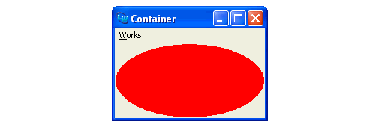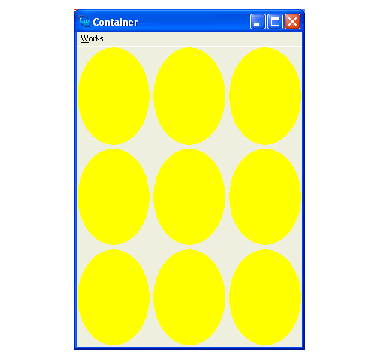






To create your own pinboard objects, the class
drawn-pinboard-object
is provided, which is a
pinboard-object
that accepts a
display-callback
to display itself. The following example creates a new subclass of
drawn-pinboard-object
that displays an ellipse.
(defun draw-ellipse-pane (gp pane
x y
width height)
(with-geometry pane
(let ((x-radius
(1- (floor %width% 2)))
(y-radius
(1- (floor %height% 2))))
(gp:draw-ellipse
gp
(1+ (+ %x% x-radius))
(1+ (+ %y% y-radius))
x-radius y-radius
:filled t
:foreground
(if (> x-radius y-radius)
:red
:yellow)))))
(defclass ellipse-pane
(drawn-pinboard-object)
()
(:default-initargs
:display-callback 'draw-ellipse-pane
:visible-min-width 50
:visible-min-height 50))
(contain
(make-instance 'ellipse-pane)
:best-width 200
:best-height 100)
Figure 11.7 An ellipse-pane class

The
with-geometry
macro is used to set the size and position, or geometry, of the ellipse drawn by the
draw-ellipse-pane
function. The fill color depends on the radii of the ellipse - try resizing the window to see this. See the
LispWorks CAPI Reference Manual
for more details of
drawn-pinboard-object
.
Now that you have a new ellipse-pane class, you can create instances of them and place them inside layouts. For instance, the example below creates nine ellipse panes and place them in a three by three grid.
(contain
(make-instance
'grid-layout
:description
(loop for i below 9
collect
(make-instance 'ellipse-pane))
:columns 3)
:best-width 300
:best-height 400)
Figure 11.8 Nine ellipse-pane instances in a layout
